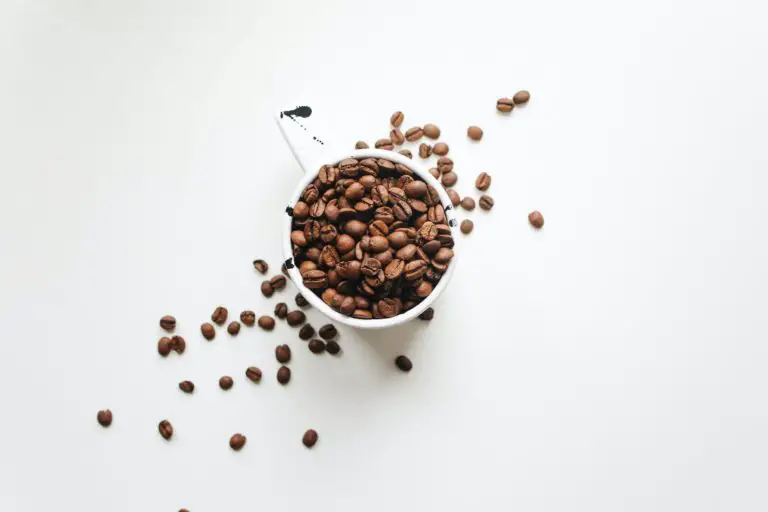How Long Can You Store Green Coffee Beans
As a master of the coffee universe, I’ve been known to keep green coffee beans fresh for what feels like eons. In my pursuit of the perfect cup, I’ve learned that storing green beans is an art form in itself.
You can generally bank on a shelf life of 6-12 months, provided the conditions are just right. I always store my beans in a cool, dry place, far from any heat or light, which are notorious flavor thieves. An airtight container or vacuum-sealed bag is my go-to, acting as a fortress against the enemies of freshness: moisture and odors.
As time ticks on, I stay vigilant, knowing the beans’ peak flavor is a fleeting treasure. With these practices, I ensure that when it’s time to roast, my green beans are as ready as they’ll ever be for their moment in the spotlight.
Key Takeaways
- Green coffee beans can maintain their freshness over extended periods when stored appropriately.
- Consistent temperature and humidity control are key to prolonging freshness.
- Shield green coffee beans from light to maintain their longevity and flavor profile.
- Packaging serves as a critical barrier against environmental factors that degrade quality.
Understanding Green Coffee Beans
Before I delve into the specifics of storage, it’s essential to grasp what green coffee beans are and why they differ from their roasted counterparts.
Green coffee beans are the seeds of coffee cherries that have been processed but not yet roasted. Their inherent chemical stability and dense nature render them less vulnerable to deterioration. Proper storage conditions, particularly those that mitigate fluctuations in moisture content, are crucial in preserving their quality.
Unlike roasted beans, which quickly lose aromatic compounds, green coffee can maintain its freshness over extended periods when stored appropriately. Understanding the optimal conditions for storage is fundamental for aficionados seeking to master the art of coffee preservation.
Now, let’s explore the factors affecting bean longevity, which play a pivotal role in maintaining the essence of green coffee.
Factors Affecting Bean Longevity
As I turn my attention to how long you can keep those green coffee beans fresh, I can’t ignore the role of storage environment conditions.
It’s clear that the place you store your beans, be it cool or humid, directly impacts their shelf life.
Also, the moisture content within the beans themselves plays a crucial part in maintaining their quality over time.
Storage Environment Conditions
In managing my green coffee bean storage, I’ve found that maintaining a consistent environment free from extreme temperature fluctuations and high humidity is key to prolonging their freshness. Here’s how I achieve that:
- Control Moisture Levels: I monitor the humidity around my beans, striving to maintain it between 11-12.5%. This minimizes the risk of mold and quality degradation.
- Select a Dry Place: I store my beans in a location that’s inherently dry, avoiding basements or other areas prone to dampness.
- Shield from Direct Sunlight: I keep the beans away from windows and areas where sunlight pours in, as direct sunlight can accelerate deterioration.
Bean Moisture Content
After ensuring the storage environment is optimal, I’ll turn my attention to the bean moisture content, a pivotal factor that directly impacts the longevity of green coffee beans. Precision in maintaining the right moisture level is crucial. If the beans absorb too much moisture, mold can ruin the entire batch. Conversely, an overly dry environment will sap them of flavor and quality. Mastery of storage techniques, like using properly sealed bags or airtight containers, is essential to safeguard the beans’ integrity.
Here’s a table to break down the essentials:
| Factor | Impact on Bean Moisture Content |
|---|---|
| Sealed Storage | Prevents moisture fluctuations |
| Pallet Stacking | Reduces ground moisture absorption |
| Light and Temperature Control | Mitigates deterioration rate |
Understanding and controlling these elements ensures that my green coffee beans remain pristine for as long as possible.
Optimal Storage Conditions
Now, let’s turn our attention to the optimal storage conditions for green coffee beans.
I’ll explore how temperature control, humidity, and light exposure each play a crucial role in preserving the freshness and flavor of these beans.
Understanding these factors is key to extending the shelf life of your green coffee stash.
Temperature Control
While I ensure the temperature remains steady between 68-77ºF (20-25ºC), I’m creating the optimal conditions to store green coffee beans for an extended period. Temperature control is crucial for preventing moisture from compromising the quality of the beans.
Here’s how I maintain a mastery level of control:
- Monitor Consistently: I use a digital thermometer to track the room temperature, ensuring it doesn’t fluctuate beyond the ideal range.
- Mitigate Humidity: To avoid moisture getting into the storage area, I use desiccants and maintain adequate ventilation.
- Strategic Placement: I store the beans off the ground, preferably on pallets, to prevent moisture from concrete floors affecting them.
Humidity Considerations
I’ve tackled temperature regulation, and now I’ll turn my attention to maintaining the ideal humidity levels, which is just as critical for the longevity of green coffee beans in storage. Humidity considerations are paramount in long term storage to prevent mold and preserve the delicate flavor profiles of green beans. The optimal humidity range is narrow, and precision is key.
Here’s a concise table that encapsulates the core principles of humidity management:
| Factor | Ideal Condition | Impact on Green Beans |
|---|---|---|
| Humidity Level | 11-12.5% | Prevents mold, maintains quality |
| Storage Environment | Light-proof, stable | Protects from moisture damage |
| Bean Placement | Elevated on pallets | Minimizes moisture absorption |
Adhering to these guidelines ensures the green beans remain in pristine condition for as long as possible.
Light Exposure Effects
Turning to the effects of light exposure, I’ll highlight that the importance of shielding green coffee beans from light is paramount for maintaining their longevity and flavor profile. Green coffee beans are particularly susceptible to light exposure effects, which can degrade their quality. To ensure these beans are protected, consider these optimal storage conditions:
- Store green coffee in light-proof bags or containers to prevent photo-degradation.
- Place beans in a basement or cabinet where light penetration is minimal.
- Utilize vacuum-sealed mason jars to protect against both air and light, greatly extending freshness.
These methods are essential in preserving the delicate nuances of the beans.
Now, let’s delve into the role of packaging, which plays a critical component in safeguarding green coffee beans from environmental factors.
The Role of Packaging
In assessing the longevity of green coffee beans, I’m focusing on the role of packaging, which serves as a critical barrier against environmental factors that can degrade quality.
Traditionally, burlap bags have been the standard for transporting green coffee beans. However, though they offer some protection, they’re not impervious to air and moisture.
To maximize shelf life, vacuum sealing green coffee beans provides an excellent defense, ensuring that oxygen and humidity are minimally impactful. Furthermore, the integration of high barrier liners within jute bags has significantly advanced the preservation capabilities of these containers. Airtight or multi-layer packaging further extends freshness, offering superior safeguarding against the perils of fluctuating temperatures and moisture levels.
To truly appreciate the efficacy of these storage solutions, let’s delve into recognizing freshness decline.
Recognizing Freshness Decline
As a coffee enthusiast, I’m tuned into the subtle changes that indicate a decline in the freshness of green coffee beans. Recognizing freshness decline is crucial to prevent the unpleasant experience of brewing old coffee. Here’s what I look for:
- Bagginess: A burlap-like taste that suggests the beans have absorbed unwanted flavors from their storage environment.
- Degraded Lipids: A rancidity or flatness in flavor, which occurs as the fats within the bean go bad.
- Loss of Acidity: Bright, acidic coffees that become insipid and mild with age, losing their intrinsic character.
Understanding these signs helps maintain the quality of green coffee. Let’s pivot now to prevent such degradation by examining common storage mistakes.
Common Storage Mistakes
I’ve learned that improper storage is one of the quickest ways to compromise the quality of green coffee beans. Storing them in environments that are hot or too cold can wreak havoc on their freshness. Similarly, a space that’s humid or too dry poses a threat to their integrity.
The original packaging often doesn’t offer adequate protection against these elements, and plastic bags can sometimes exacerbate the issue by trapping moisture or odors. Moreover, I’ve noticed that placing green coffee beans near pungent substances can infuse them with unwanted flavors.
Additionally, frequently opening their containers exposes the beans to air and light, accelerating the decline in quality. I’m careful to avoid these pitfalls to ensure the beans maintain their optimal condition.
Extending Shelf Life Tips
To extend the shelf life of green coffee beans, I’ll focus on optimal storage methods that protect their quality and freshness. Here are my top recommendations:
- Store in a Cool, Dry Place: Temperature fluctuations and moisture are the enemies of green coffee beans. I make sure to keep them in a cool, dry environment to prevent mold and degradation.
- Use Airtight Containers: Oxygen exposure can compromise the integrity of the beans. I prefer using vacuum-sealed bags or airtight containers to maintain a longer shelf life.
- Consider Freezing for Long-Term Storage: If I’m planning to store green coffee beans for an extended period, I’ll vacuum seal them and store them in the freezer, essentially locking in their freshness indefinitely.
Storing Vs. Roasting Timelines
I’m comparing the longevity of stored green coffee beans to the much shorter shelf life of their roasted counterparts. Green coffee can stay fresh for months, if not years, under optimal conditions. In contrast, roasted beans have a fleeting peak, with different roast levels affecting their shelf life.
Here’s a concise table to illustrate this:
| Storage Type | Green Coffee | Roasted Coffee |
|---|---|---|
| Shelf Life | 6-12 months+ | 2-4 weeks |
| Optimal Use | Long-term | Immediate |
| Degradation | Slow | Rapid |
Mastering storage techniques ensures that green coffee maintains its integrity before roasting. Once roasted, the clock ticks faster, and you’ll want to enjoy those beans while their unique characteristics are at their zenith. Understanding these timelines is crucial for anyone serious about coffee quality.
Frequently Asked Questions
How Do You Store Green Coffee Beans Long Term?
I store my green coffee beans long-term by vacuum sealing them in mason jars and freezing at -5°F, ensuring they’re in a dark, moisture-free environment to maintain their quality and freshness.
How Can You Tell if Green Coffee Beans Are Old?
I assess green coffee beans’ age by their aroma, flavor, and moisture. Stale beans often lose their vibrant scent, taste flat, and feel brittle, indicating they’ve surpassed their peak freshness.
How Long Do Green Beans Stay Good For?
Green beans maintain their freshness for about a week in the fridge. I store them in a plastic bag with some air circulation to ensure they stay crisp and avoid spoilage.
Do Raw Coffee Beans Go Bad?
Yes, raw coffee beans can go bad, but it takes a long time. Stored properly, they remain good for months, although the flavor might change. Vacuum-sealing and freezing can extend their shelf life further.
Conclusion
In my quest to preserve the essence of my cherished green coffee beans, I’ve learned that attention to detail is paramount. Properly stored, they can remain my morning’s aromatic delight for up to a year, possibly more if vacuum-sealed and frozen.
Yet, without care, their vibrancy fades, a stark reminder of nature’s fleeting gifts. I’ll treasure each brew, knowing the effort I put into storage preserves not just the beans but the joy they bring to my cup.







